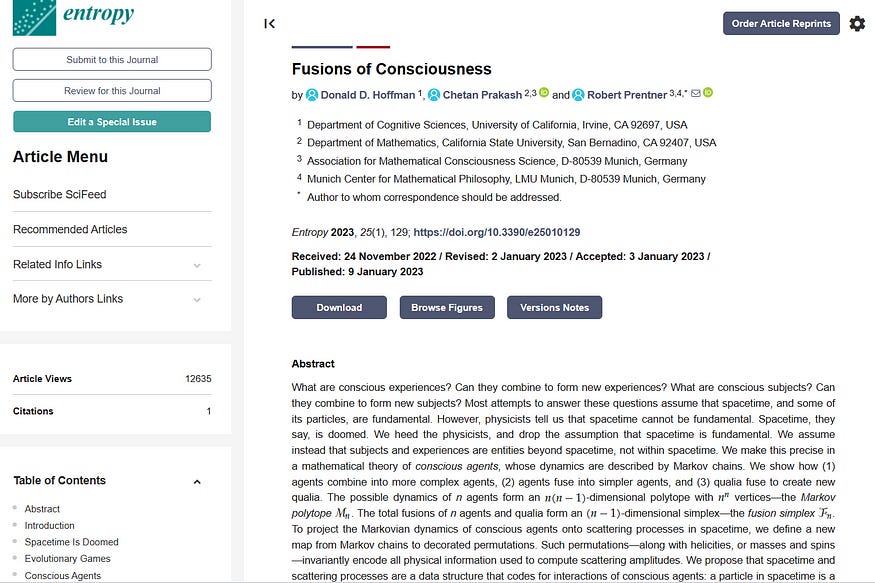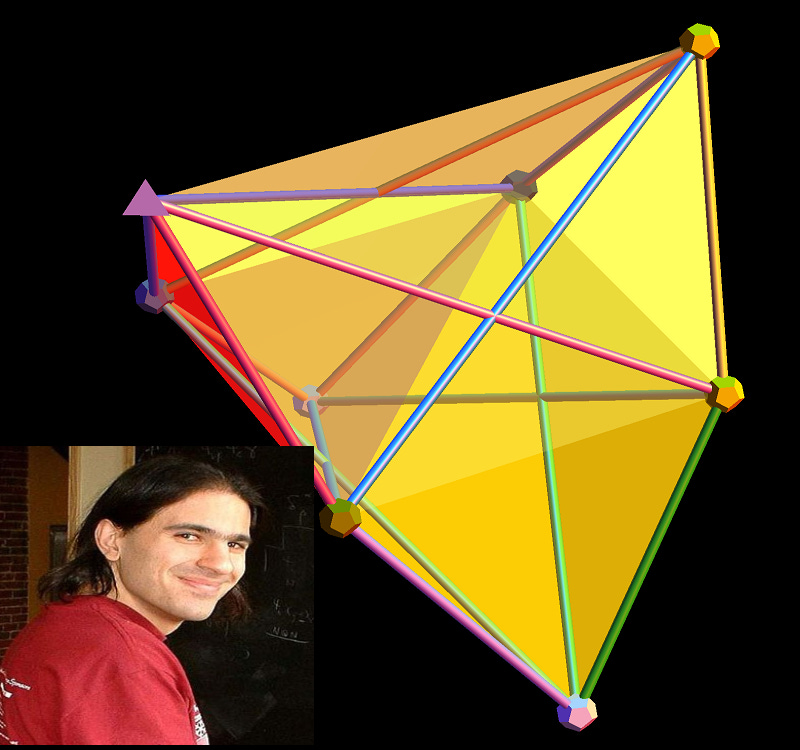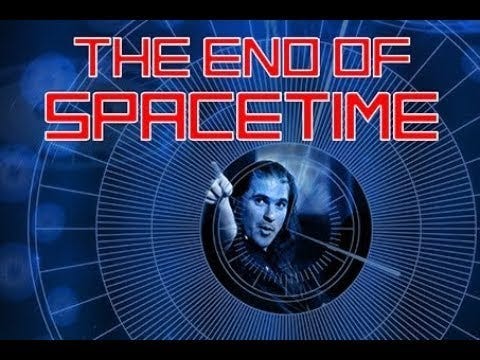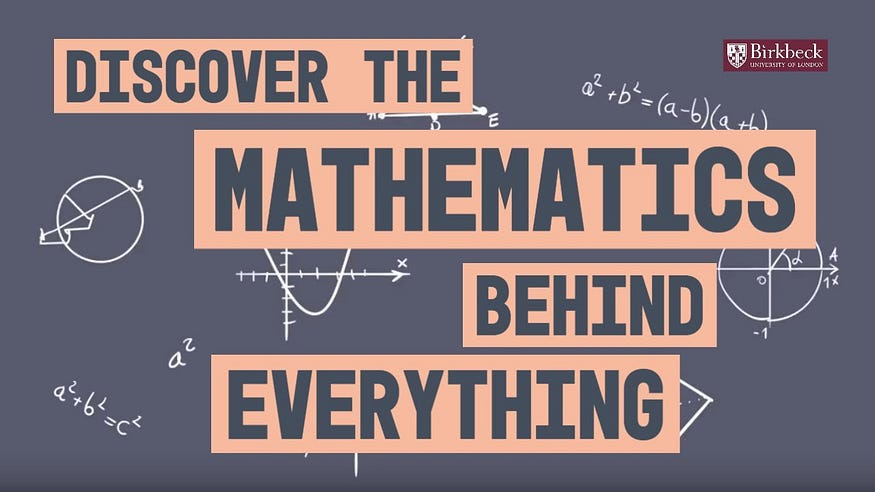How Professor Donald Hoffman Uses Mathematics: From Idealism to the Amplituhedron
Professor Donald Hoffman is a philosophical idealist. Professionally, he’s also a cognitive psychologist. At some point after 2013, Hoffman discovered that a small number of theoretical physicists were claiming that “spacetime is doomed”. He particularly noted the work of Nima Arkani-Hamed and his amplituhedron. More relevantly, Hoffman realised that he could use the work of certain contemporary theoretical physicists to advance his own brand of idealism (i.e., “conscious realism”), in which “conscious agents” and their “interactions” are the ground of all reality. He published his conclusions in the 2023 paper ‘Fusions of Consciousness’.

(i) Introduction
(ii) Donald Hoffman’s Idealism in Some Context
(iii) The Amplituhedron
(iv) Donald Hoffman on The Physicists
(v) Psychological, Physical and Ontological Space and Time
(vii) Donald Hoffman on Reductionism
(viii) Conclusion
It’s clear that Donald Hoffman isn’t mentioning — and extensively relying upon — the work of theoretical physicist Nima Arkani-Hamed and the (or his) amplituhedron for the hell of it. He’s using such geometrical models and theories from theoretical physics to advance his own philosophical idealism — something he calls conscious realism.
Basically, Hoffman’s simple and, he must believe, monumental trump card is to argue that all rival philosophical theories “assume spacetime”. Thus, Hoffman is offering an ontology and theory of consciousness that is (in his own eyes) truly original…
The words “truly original” are used because although some physicists may well have moved beyond spacetime (as Hoffman is very keen to tell us), philosophers haven’t…
There are many places in which Hoffman states all this (if not in my own colloquial way). Take this single example:
“[I]f you actually ask the the people who are using it, where they think is actually being instantiated, it’s in spacetime. It’s in neurons or circuits or what any physical system that has the right integrated information. They’re not looking for instantiation outside of spacetime. [] So I would say that functionalist, physicalist, and even panpsychist approaches to consciousness all have this problem.”
The passage above could just as easily be about particles or any other objects (i.e., not neurons, circuits, etc.). Indeed, Hoffman argues exactly the same thing about quantum information:
“[Q]uantum information viewed abstractly, not as embedded in spacetime. Spacetime and objects somehow emerge from non-spatial and non-temporal dynamics of quantum information.”
Thus, Hoffman’s defence of idealism is — at least now! — almost entirely based upon moving beyond spacetime.
In detail, then, Hoffman tells us that the
“big pillars of modern science, evolutionary theory, quantum field theory and general relativity are agreeing that spacetime isn’t fundamental”.
… Then comes the clincher (if from a different source — see here):
“Maybe it’s time for us to move on. Maybe it’s time for us to look for structures beyond spacetime. And that, of course, has huge implications for theories of consciousness.”
Hoffman is even more explicit when he says the following:
“It’s over for spacetime. Great. So neurons don’t create consciousness [].”
To Hoffman, all this means that virtually all theories of consciousness are false. They’re all false because they all assume spacetime. In Hoffman’s own words:
“Basically, 99% of theories of consciousness that are on offer today just assume — as a matter of course — that space and time are fundamental.”
Yet Hoffman was an idealist long before all this stuff about the death of spacetime.
He held at least some of his idealist views long before physicists began to say “spacetime is doomed”. For example, in a 1998 book called Visual Intelligence: How We Create What We See, Hoffman was already hinting at idealism, as suggested by both the title itself and by the actual contents of the book. Indeed, Hoffman’s idealism may well be dated back to his 1989 book Observer Mechanics: A Formal Theory of Perception — and quite possibly before that too.
Thus, Hoffman was an idealist some 15 years — at the very least — before he discovered that the amplituhedron was useful to him. (The amplituhedron was first introduced by Nima Arkani-Hamed and Jaroslav Trnka in 2013.)
What’s more, it’s hard to find many uses of the phrase “spacetime is doomed” before 2017. Yet, in only the last seven years or so (especially since 2022), the phrase has become commonplace in physics and popular science. (The earliest reference I could find was in 2010.)
Of course, it can be supposed that Hoffman may (or at least he could) argue that contemporary theoretical physicists are simply showing us what idealists and “ancient religions” knew all along! So this means that Hoffman can state the following:
Of course contemporary theoretical physics is now squaring with idealism. And that’s simply because idealism is true.
[Constructivists warn against using the word “true” (as they also do with the word “reality”), as will be shown later.]
[I won’t be discussing Hoffman’s many relations to — and comments upon — religion and spirituality in this essay. That’s because I’ve done so elsewhere. That said, as a preamble, take a look at ‘Donald Hoffman on The Intersection of Science and Spirituality’, in which he quotes — from memory — words from the Upanishads, discusses the ideas of the “spiritual teacher” Eckhart Tolle, and then connects all of that to his “mathematical models of consciousness”. In fact, Hoffman explicitly says that he “takes these ideas and makes them mathematically precise”. See my essay ‘Donald Hoffman’s Case For An Idealist and Spiritual Reality’.]
Donald Hoffman’s Idealism in Some Context
It can be assumed that one of Donald Hoffman’s cowriters, the “independent” mathematician Chetan Prakash, has done much — or even most — of the mathematical work on Nima Arkani-Hamed’s amplituhedron, and also on the very extensive mathematics in Hoffman’s 2023 paper ‘Fusions of Consciousness’. (Hoffman has been working with Chetan Prakash since at least 1989.) After all, Hoffman is a cognitive psychologist. That is, he’s neither a mathematician nor a physicist. Of course, Hoffman is bound to know at least some maths and physics, as all scientists do.
Most readers won’t understand much of the mathematics in Hoffman’s paper ‘Fusions of Consciousness’. (I suspect that Hoffman doesn’t either.) In any case, most of the maths in this paper is besides the point, gratuitous and (for want of a better word) pretentious (i.e., when it comes to advancing Hoffman’s philosophical position of conscious realism). In addition, much of the maths simply restates stuff (i.e., without much — or sometimes any — change) from a wide range of 20th century physics.
It’s also worth offering a few words on the journal Constructivist Foundations here, as it will help put Hoffman’s project in its larger context.
Chetan Prakash and Robert Prentner (the other co-writer who’s involved in nearly all Hoffman’s papers) both write for Constructivist Foundations, and are part of the Constructivist Community, as is Donald Hoffman himself (see here). In the ‘Acknowledgments’ at the end of the paper, the only other people who are thanked for their help are Joe Arpaia (who is, as far as I can see, a psychiatrist), Ben Knepper (who’s a research student, as of 2023), and Manish Singh (who’s a cognitive psychologist, like Hoffman).
As for constructivism itself (i.e., rather than idealism), take the following definition:
“The collective term ‘constructivism’ (from Lat. construere: to construct) covers all theories of cognition, which particularly emphasize the active contribution of the subject in the process of cognicizing.”
An introduction to the Constructivist Foundations journal includes the following words:
“Constructivist approaches entertain an agnostic relationship with reality, which is considered beyond our cognitive horizon; any reference to it should be refrained from.”
Elsewhere in the introduction, there is this passage:
“[A]uthors are asked to be careful with philosophically burdened and ambiguous notions such as ‘real,’ ‘actual,’ ‘true’ and ‘fact,’ and their derivatives ‘reality,’ ‘really,’ ‘truth,’ ‘factual,’ etc.”
Thus, Hoffman is clearly part of a “community” of academics with a very particular philosophical bias.
The words from Constructivist Foundations directly above can be read as — at least obliquely — endorsing various forms of idealism, as well as (obviously) constructivism itself.
In any case, it’s certainly correct to say that idealism is central to Hoffman’s entire project. Indeed, if pushed, Hoffman would probably not deny this… except for the irrelevant detail that he rarely (if ever) uses the actual word “idealism” about his own ideas and work. Hoffman prefers, instead, his own neologism - “conscious realism”.
That said, Hoffman does tells us about “objective idealism” and how it relates to his work. What’s more, although the German philosopher G.W. Leibniz isn’t usually (strongly) associated with idealism, Hoffman has relied extensively on his ideas. More relevantly, Hoffman connects Leibniz’s monads to his own “conscious agents”.
Thus, we have these words from Hoffman:
“All of the above falsely assume that spacetime physics is fundamental. This is not the case, for example, in the system of G.W. Leibniz who proposed that simple substances (‘monads’) are the ultimate constituents of the universe and that physics, as it was known back then, would result from the dynamics of a network of such monads.”
Hoffman expands on his debt to Leibniz in the following passage:
“Our posits for the notion of a conscious agent mirror G.W. Leibniz’s posits for his notion of a simple substance: ‘there is nothing besides perceptions and their changes to be found in the simple substance. Additionally, it is in these alone that all the internal activities of the simple substance can consist’.”
So how does Hoffman rebrand Leibniz?
In very basic terms (or perhaps not), Hoffman is substituting the word “particle” with the word “conscious agent” (or at least particles are deemed to be the “projections” of interacting conscious agents), just as the word “monad” is also substituted with the words “conscious agent”. And that explains much of the verbatim (or textbook) mathematical physics in his paper. That is, a lot of standard physics is replicated in Hoffman’s paper, the main difference being that he’s arguing that particles are actually the projections of interacting conscious agents. (In Hoffman’s technicalese: “A particle in spacetime is a projection of the Markovian dynamics of a communicating class of conscious agents.”)
Ironically, Hoffman actually quotes the philosopher Philip Goff seemingly picking up on the same — or at least a similar — point in 2021. Goff wrote:
“It’s been hard enough to get the equations of physics we already have. Coming up with a whole new level of mathematical structure underneath that, which yields precisely the same predictions, is rather a large challenge. Moreover, I can’t see the motivation for taking on that challenge.”
[Philip Goff is a panpsychist. There are a fair few criticisms of panpsychism in Donald Hoffman’s ‘Fusions of Consciousness’, as well as in his other works.]
Despite Goff’s words, this is how Hoffman puts it in his own technicalese:
“We propose that spacetime and scattering processes are a data structure that codes for interactions of conscious agents: a particle in spacetime is a projection of the Markovian dynamics of a communicating class of conscious agents.”
Elsewhere, Hoffman writes:
“[D]ecorated permutations are a convenient précis of the dynamics of conscious agents, and we conjecture how to relate spacetime-physics to the combination and fusion of conscious agents.”
Hoffman’s idealism is most explicitly put in the following:
“Stipulate a dynamics of experiences and derive, rather than stipulate spacetime and objects as a projection of the dynamics. This is the project of the theory of conscious agents.”
Thus, in the old language of idealism, “objects” are simply the product of either an individual subject (as in certain brands of subjective idealism) or a collective set (however large) of subjects (as in certain brands of objective idealism). In Hoffman’s own scheme, objects and spacetime are projections of interacting conscious agents. This puts Hoffman in the same camp as certain brands of objective idealism.
In any case, in order to demonstrate that space and time are not “fundamental”, Hoffman has relied on the work of the theoretical physicist Nima Arkani-Hamed.
The Amplituhedron
So now let Donald Hoffman himself tell us about Nima Arkani-Hamed and Jaroslav Trnka’s amplituhedron. Hoffman wrote:
“Another new candidate is a class of geometric constructions outside of space and time, including the amplituhedron discovered by Nima Arkani-Hamed and Jaroslav Trnka. Subatomic particles collide and scatter in a multitude of ways, and physicists have for decades had formulas for computing their probabilities, formulas that assume physical processes which evolve locally in space and time. But, as it happens, these formulas are unnecessarily complex and hide deep symmetries of nature. The amplituhedron simplifies the formulas, exposes the symmetries hidden by space-time and, in the process, abandons the assumption that space and time are fundamental.”
This was written in 2016 in an Edge.org article called ‘The Abdication Of Space-Time’. Despite it seeming to offer readers this “new candidate” as just another option, it’s clear that Hoffman was already committed to it.
Hoffman also told us that amplituhedron theory is “a new game in town, and it’s less than 10 years old”. (Actually, from what I can see, it was less than less than 10 years old in 2016.)
Isn’t it odd that Hoffman was completely committed to this “new game in town”? After all, it was “less than 10 years old” at the time. This is especially odd because Hoffman himself isn’t either a mathematician or a physicist.
In this Edge.org article from 2016, Hoffman is fairly modest, and qualifies his position on “the death of spacetime”. However, when being interviewed for YouTube videos, in popular-science articles, etc., he is far from modest, and he doesn’t qualify his position on spacetime at all. This is especially the case when Hoffman is being interviewed by non-physicists (which is always the case) and those who’re clearly sympathetic to his idealist views. What’s more, as yet, I haven’t come across Hoffman discussing these issues with professional physicists, professional mathematicians or with any other professional scientist outside his idealist (or constructivist) colleagues and cowriters.
So what about the amplituhedron itself?
Non-physicist readers can view Nima Arkani-Hamed’s amplituhedron as a geometrical tool which is used by theoretical physicists. It can also be seen as a pure abstraction. (The words “highly abstract” are often used about the amplituhedron.) In other words, amplituhedron theory provides physicists with a geometric model that is essentially abstract. Indeed, it’s abstract primarily because the geometrical space it offers theoretical physicists is not a (physical) spacetime. (In that limited sense, the amplituhedron is abstract in the same way that — at least on most readings — the wave function and Hilbert space are.)
More technically, how, exactly, can a geometrical tool which simplifies the calculations of the interactions of particles be tied to Hoffman’s philosophical idealism? (Arkani-Hamed himself has stated that the amplituhedron helps simplify scattering-amplitude calculations.) Inversely, how can Hoffman’s philosophical idealism be tied to a very particular model of particle interactions?
Of course, some physicists (almost certainly very few) may well believe that amplituhedron theory does far more than merely simplify things. They may take it to be an ontological theory about the nature of reality…
Donald Hoffman certainly does.
So, again, why Hoffman’s strong focus (or reliance) on Arkani-Hamed’s amplituhedron?
Donald Hoffman on The Physicists
In one interview, Donald Hoffman keeps on saying that “physicists” (i.e., in the plural) are saying this and saying that. (Hoffman also keeps on using the definite article - as in “the physicists”.) He did something similar when he said that
“the younger generation is boldly going beyond spacetime and finding structures like the amplituhedron and decorative permutations”.
Hoffman also said:
“The physicists independently have decided that spacetime was doomed — that the spacetime is not fundamental, which is stunning because physics until recently has been about what happens in spacetime.”
As may already be clear, Hoffman often basically means one particular theoretical physicist — Nima Arkani-Hamed. (To be careful, perhaps Hoffman also has in mind a handful of other theoretical physicists who fully endorse what Arkani-Hamed has had to say on this highly-technical and abstract field of theoretical physics.)
What’s more, even the small number of theoretical physicists who also believe that “spacetime is doomed” don’t do so in precisely the same way in which Arkani-Hamed does.
So — again — when Hoffman uses the word ”physicists” to back up his philosophical idealism, he basically means a small number — or even a single - theoretical physicist.
One well-known physicist who doesn’t seem to be fully on board with Hoffman is Edward Witten. That said, Witten did once acknowledge that Arkani-Hamed’s work is “very unexpected”. Then he added that “it is difficult to guess what will happen or what the lessons will turn out to be”. Indeed, Hoffman himself wrote that Witten only “thought” that space and time “may be” doomed.
Hoffman, on the other hand, believes that spacetime is doomed.
Hoffman has also guessed what will happen. What’s more, he has already learned what the lessons are — at least for philosophy and our notions of “reality” generally.
Psychological, Physical and Ontological Space and Time
Donald Hoffman brings on board the theoretical physicist Nathan Seiberg, whom he quotes as saying that “space and time are illusions”.
Are they?
It depends.
Even if spacetime is dead, space and time still aren’t illusions.
This point has parallels with a conceptual mistake which the philosopher David Chalmers picked up on when he argued that virtual-reality images aren’t illusions (see here). Nonetheless, actually taking a simulation of, say, a unicorn to be an actual unicorn may well be an illusion.
The same is (loosely) true of space and time.
The argument here is that not many people philosophise about space and time. Thus, they (as it were) make do with what is called psychological time (or time perception). Thus, new abstract and highly-technical mathematical theories and models in theoretical physics (i.e., the ones which Hoffman uses) don’t impinge on psychological time (or times). That’s unless specific individuals decide to looks into the physics of space and time, and then develop an ontology about them.
What’s more, physicists have nearly always made a distinction between space and time as they are dealt with in physics and cosmology, and psychological time. Hoffman, on the other hand, fuses these two different things together. Either that, or doesn’t care to note the difference.
Thus, even if the most radical contemporary views of spacetime (even that it’s doomed) are true, that may still not have any impact on psychological time (or even on Kantian space and time). Indeed, spacetime may well be doomed in specialised theoretical physics, and we can still say — So what!
Thus, when Hoffman says that spacetime is doomed, and that this “will raise new questions for researchers in perceptual psychology”, readers may wonders what these “new questions” are, and whether or not they really do impact on perceptual psychology.
Again, perceptual psychology doesn’t offer us an ontology of space and time.
So how, exactly, do these highly-abstract and highly-technical mathematical theories of spacetime (or its death) impinge on perceptual psychology? In other words, even if “reality is an illusion” (partly) because spacetime is dead, then that may still not impact on perceptual psychology.
Hoffman goes on to say the same kind of thing about a broader discipline — cognitive neuroscience. He says that
“spacetime has no operational meaning beyond 10 to the minus three to three centimetres 10 to the minus 43 seconds”.
Again, for cognitive neuroscientists it may simply not matter if spacetime is dead — even if that’s the case!
Of course, if cognitive scientists happen to be interested in ontology, then that’s fine. However, these things hardly — if at all — impact on cognitive neuroscience qua cognitive neuroscience.
Hoffman himself, on the other hand, has (as it were) branched out.
Moreover, Hoffman has branched out because he has specific philosophical concerns.
More correctly, Hoffman is interested in using tools from theoretical physics to advance his philosophical idealism. One can suspect that most cognitive scientists, on the other hand, don’t have such philosophical concerns.
Of course, Donald Hoffman — just like the more explicit and rhetorical idealist Bernardo Kastrup — may argue that such scientists are already implicitly (if rarely explicitly) committed to “materialism”. Thus, Hoffman is offering scientists a superior ontology — idealism!
Again, Hoffman is fusing ontological (actually, his own philosophical position of conscious realism) with work in cognitive psychology. However, no cognitive psychologist has any need to explore ontology in any great detail, even if it interests him non-professionally.
(This means that cognitive scientists — as a whole — are in a similar position to those physicists who choose to “shut up and calculate”, rather than answer Wolfgang Pauli’s ironic question: “How many angels are able to sit on the point of a needle?” That is, most physicists don’t bother with the interpretations of quantum mechanics.)
Donald Hoffman Against Reductionism
Donald Hoffman mentions reductionism a few times.
Like spacetime, he believed that reductionism is doomed too.
So it’s odd that a person who criticises reductionism has carried out what can be seen as the most ultimate reduction imaginable. (Sure, carrying out specific — even many — scientific reductions isn’t the same thing as being committed to philosophical reductionism.)
Hoffman believes that he has reduced (what people take to be) reality down to what he calls “conscious agents” and their “interactions”. More relevantly to this essay, he has used the work of Nima Arkani-Hamed to do so.
Perhaps Hoffman believes that what he’s doing is not a case of reduction simply because he reduces objects, neurons, brains, reality, spacetime, human beings, etc. to non-physical — or even “spiritual” — conscious agents and their interactions. However, how does the non-physicality of these things stop it from being a reduction?
Hoffman also offers us a virtual non sequitur about reductionism.
Firstly, he tells us that it “is very clear that reductionism is dead”. He continues:
“The idea that as you go to smaller and smaller scales in space you find more and more fundamental laws, and more and more fundamental entities governed by those laws.”
Then Hoffman moves on to say that when it comes to Nima Arkani-Hamad’s ideas on the death of spacetime, he hopes that his
“colleagues will really pay attention to what the physicists are telling us and and let go of this reductionist point of view”.
Again, isn’t that precisely what Hoffman has done — reduced all things to to conscious agents and their interactions?
More technically, it’s not clear why these discoveries of scales smaller than what Hoffman calls “10 to the minus 33” herald the death of reductionism. After all, this can actually be deemed to be a vindication of reductionism in that a final rock bottom has been discovered. Not only that: no physicist I know has ever been committed to (as Hoffman puts it) “going smaller and smaller” ad infinitum. Historically, the opposite has been the case in the sense that various particles (perhaps also laws and forces) were once seen as being rock-bottom.
What’s more, Hoffman’s words about quantum non-locality and entanglement don’t seem to directly impact on reductionism (i.e., if that ism isn’t some kind of caricature). That’s because non-locality and entanglement have also been built into theories that both do and do not include spacetime, and which are still — at least partly — reductionist in nature. In fact, the “holistic” and widespread notions of systems, states and interactions have been parts of physics since the 1920s — and even before that. Thus, few physicists have ever seen a particle as being what philosophers call a particular (i.e., when they think about these things philosophically at all). It’s also clear that — since the late 1920s, if not before — few physicists have taken a rigid view of space and time when it came to their experimental work.
Conclusion
Donald Hoffman himself comes clean as to why he’s put so much faith in Nima Arkani-Hamed’s work on “the death of spacetime”. He said:
“With my my collaborators, where we let go of spacetime, we have a theory of consciousness outside of spacetime and we’re using decorated permutations that the physicists say are the deepest structure they found.”
Without being a literary theorist (or reader), it’s worth noting how Hoffman says “we’re using” (as in “we’re using decorated permutations”). Thus, just as these abstract geometrical entities are tools which are used in theoretical physics, so they’re also tools which are used by Hoffman to advance his philosophical idealism.
In terms one technical detail, Hoffman is explicit when he writes that “decorated permutations are a convenient précis of the dynamics of conscious agents”.
As can be seen, Hoffman does at least use the words “convenient précis”. Those words hint at the fact that Hoffman is happily admitting that all this stuff from highly-technical theoretical physics is simply a way to advance his philosophical idealism.
What’s more, even if all the maths (i.e., those parts not directly connected to conscious agents, qualia, consciousness, etc.) is correct (if mainly gratuitous) in Hoffman’s paper ‘Fusions of Consciousness’, how does it all tie in to Hoffman’s idealism?
It can be argued that it doesn’t at all.
Readers should take a very sceptical (perhaps cynical) view of what Hoffman is doing.
That’s because what Hoffman is doing is not too dissimilar to what Creationists, flat-earthers, “spiritual teachers”, believers in the paranormal and ESP, etc. do when they include lots of maths and physics in their writings.

In other words, Hoffman is using all this maths and physics to tart up his speculative philosophical theory — a philosophical theory which is also strongly and deeply connected to all sorts of religious (or “spiritual”) stuff.
Of course, most readers of ‘Fusions of Consciousness’ will be blinded by the very-large amount of mathematical detail. And many — even most — mathematicians and physicists will be confused by the references to “consciousness”, “qualia”, “conscious agents”, “monads”, “panpsychism”, “subjective experience”, “objective idealism”, “the hard problem of consciousness”, “the combination problem”, etc.
So perhaps creating such confusion and perplexity was precisely Hoffman’s intention!
More specifically, in his paper it still isn’t made clear how something “beyond spacetime”, and smaller than than the Planck scale (see here), could be conscious, let alone be an agent. Of course, this may simply be because Hoffman is using the words “conscious agent” in his very own particular way…
Indeed he is!
Hoffman knows that physicists and mathematicians (except the two idealists who cowrote the paper) aren’t reading his work. That is, there’s little evidence that any mathematicians or physicists are reading any of this “constructivist” stuff from Hoffman and his two cowriters.
In parallel, Hoffman also knows that most (i.e., not all) philosophers won’t understand the very-large amounts of mathematical detail. It’s also worth saying that, as far as I can see, no professional philosophers are engaging with Hoffman’s work either — save for Philip Goff (mentioned earlier) and Keith Frankish.
[Goff has engaged Hoffman — or vice versa — because there’s a little battle of philosophies going on between idealists and panpsychists. The idealist Bernardo Kastrup has had things to say about Goff. See here.]
Thus, Hoffman is essentially preaching to the converted.
More accurately, Hoffman is preaching to idealists — specifically, to what can justifiably be called spiritual idealists.
That said, only a tiny number of idealists, spiritual idealists and vague sympathisers will come anywhere close to understanding all the maths in Donald Hoffman’s ‘Fusions of Consciousness’.
(*) My other essays on Donald Hoffman: ‘Donald Hoffman’s Philosophy of Consciousness and Reality: Conscious Realism’, ‘A Contradiction in Donald Hoffman’s (Idealist) Fitness-Beats-Truth Theorem’, ‘Donald Hoffman’s Conscious Realism vs Panpsychism and Idealism’, ‘Professor Donald Hoffman’s Idealist Take on Brains and Volleyballs’, ‘Professor Donald Hoffman’s Mathematical Models are Eye Candy’, and ‘Donald Hoffman’s Case For An Idealist and Spiritual Reality’.
My flickr account and Twitter account.












